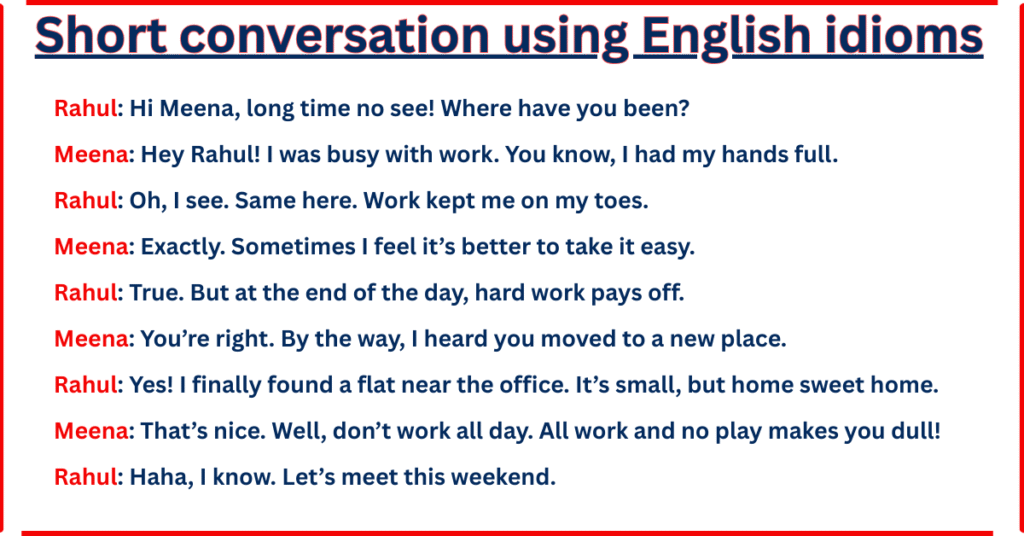
Sound Like a Native: How to Use English Idioms Naturally?
Introduction
Learning English sometimes feels like an uphill task. Grammar rules, vocabulary lists, and pronunciation can feel overwhelming. Here’s a secret recipe to upgrade your English and make it sound fluent, fun, and natural: using English idioms in daily conversations.
Now, you might be thinking: “Idioms? Aren’t they confusing?” Don’t worry! I’ll walk with you step by step, share simple explanations, and give you plenty of examples. By the end of this post, you’ll feel confident to use idioms naturally in your conversations—even if you are just a beginner.
So relax, and let’s dive in together!
What Are English Idioms?
Let us first explore what exactly English idioms are.
Idioms are expressions whose meanings are different from the meaning conveyed by individual words in them.
Example:
“It’s a piece of cake.”
(Does it mean a real cake? No! It means something is very easy.)
Another one:
“I’m feeling under the weather.”
(No, the person is not standing under the sky. It means he is feeling sick.)
See? Idioms are fun, colourful, and full of imagination. That’s why they are powerful. They make your daily conversations sound natural and fluent.
Why Idioms Are Important?
Let’s talk about why you should use idioms:
- They make you sound fluent.
If you say, “I’m sad,” it’s okay but if you say, “I’m feeling blue,” you sound like a confident speaker. - They help you connect.
Native speakers use idioms all the time—in movies, songs, workplace chats, and friendly jokes. Understanding idioms helps you fit in any conversation without feeling lost. - They make English fun.
Imagine describing something difficult as “no pain, no gain.” Doesn’t it sound cooler than just saying “work hard”?
Idioms are not just about words. They are about confidence, connection, and fluency.
Strategies to Learn English Idioms
The question is- how to actually learn and use idioms?
Don’t worry. I’ll give you practical, beginner-friendly strategies.
1. Learn 5 Idioms per Week
Don’t try to learn too many idioms at once. Small steps can make a big difference. Choose just 5 idioms every week. By the end of one month, you’ll know 20! Remember! Simply knowing them is not enough. You must use them in your speech or writing, for better retention.
2. Use Sticky Notes
Write an idiom on a sticky note and put it on your mirror, fridge, or desk. Every time you see it, say it aloud along with its meaning. Over the time, you’ll feel confident using many of them.
3. Connect to Real Life
If you just finished a difficult exam, you can say, “That was a hard nut to crack.” Linking idioms to your own experiences makes them unforgettable. Also, it is fun to use them in your conversations. It boosts your overall confidence.
4. Watch Movies/TV Shows
English movies, sitcoms, or even YouTube videos are full of idioms. Write them down when you hear them with their meaning and example. Example: In “Friends,” Joey often says, “Break a leg!” (which means good luck).
5. Keep an Idiom Notebook
Whenever you learn a new idiom, write it down with:
- Meaning
- Example sentence
- Your own sentence
This personal idiom diary will become your reference point. Refer to it frequently to revise idioms and try using some of them, in your conversation.
How to Start Using English Idioms in Conversations
The next issue is, how to actually use them in daily conversations without sounding forced. Here’s a guide:
Step 1: Start with Easy Idioms
Begin with very common idioms known to everyone.
Example:
- Piece of cake (easy)
- Break the ice (start a conversation)
- Under the weather (not well)
These idioms can be used frequently in your daily conversations.
English idioms cheat sheet for quick reference
Here’s English idioms cheat sheet you can refer to, for learning commonly used idioms.
Step 2: Try Them in Small Talk
Use them in having small talk with someone. It is an effective way to include idioms in your speech.
Example:
Friend: “How was your exam?”
You: “Oh, it was a piece of cake!”
See? Easy and natural.
Step 3: Practice With Friends
Use idioms in WhatsApp chats or while joking with friends. Even if you make mistakes, they’ll enjoy it. Eventually, you gain confidence enough to use them in formal situations as well.

Idioms used in the above mentioned conversation with meaning
- Long time no see – it’s been a long time since we met.
- Have my hands full – to be very busy.
- On my toes – to stay busy and alert.
- Take it easy – relax, don’t stress.
- At the end of the day – finally, in the end.
- Home sweet home – it feels good to be at your own home.
- All work and no play – working all the time without fun makes life boring.
Step 4: Slowly Add More
Once you’re confident, use idioms at work, in meetings, or even while writing emails (carefully). This will help you in using them more naturally.
Categories of Common Idioms
Let’s divide idioms into categories so you can learn them smartly.
1. Daily Life Idioms
- A piece of cake = something easy
- Call it a day = stop working
- Hit the sack = go to bed
- Keep an eye on – to watch carefully
- Cry over spilled milk – to waste time worrying about something that cannot be changed
Example:
I’ve been working all day. Time to hit the sack.
2. Work/Study Idioms
- Back to square one = start again
- Hit the books = study hard
- On the same page = agree with each other
- Burn the midnight oil – to work or study late into the night
- Double-edged sword – something that has both good and bad effects
Example:
We didn’t agree in the meeting. Let’s get on the same page tomorrow.
3. Emotion Idioms
- Over the moon = very happy
- Feeling blue = sad
- Hot under the collar = angry
- On cloud nine – extremely happy
- Green with envy – very jealous
Example:
She was over the moon when she got the job.
4. Time Idioms
- In the nick of time = just on time
- Around the corner = coming soon
- Once in a blue moon = very rarely
- Better late than never – it’s better to do something late than not at all
- Kill time – to do something while waiting
Example:
We see each other once in a blue moon.
5. Relationship Idioms
- Two peas in a pod = very similar
- Cold shoulder = ignore
- Break the ice = make people comfortable
- On the same page – to agree or share the same understanding
- Give the cold shoulder – to ignore someone deliberately
Example:
Riya and her sister are like two peas in a pod.
Tricks to Remember Idioms Easily
Here are some clever tricks I use with my students:
- Visualize: Imagine a real picture in your mind. For “spill the beans,” imagine beans falling from a bag. It helps in remembering the idiom easily.
- Personal Sentences: Always create your own example. Don’t just copy.It helps in retention.
- Mirror Practice: Stand in front of the mirror and talk to yourself using idioms, in your speech.
- Voice Recording: Record yourself saying 5 idioms daily. Listen later and check.
- Play Games: With friends, play “Guess the idiom” or “Finish the idiom.” Fun + learning = success.
Mistakes to Avoid
Beginners often make these mistakes:
- Using idioms without knowing meaning. Don’t just use them by guessing. This can be embarrassing, in many situations.
- Overusing idioms. Too many idioms in one sentence sound fake. Use them wisely.
- Mixing idioms. Saying “piece of weather” instead of “under the weather.” (Funny, but wrong ).
- Using wrong context. Example: Don’t use “Break a leg” when someone is actually going to hospital.
10-Minute Daily Routine
Here’s a simple routine you can follow:
- Read 1 new idiom.
- Understand meaning.
- Say it aloud 3 times.
- Write 2–3 sentences with it.
- Use it in real life that day.
At the end of the week → Review all 7 idioms.
Simple, short, and effective!
Motivation for Beginners
Learning English idioms is like learning any skill. With practice, you gain confidence to use them effectively, in your speech and writing.
- Don’t be afraid of making mistakes. They will make you more confident in using idioms.
- Even one idiom per day makes you better.
- Idioms are like spices—they make your English advanced and effective.
- Keep going. Consistency is your magic key.
Remember: Fluency doesn’t come overnight but every small effort adds up.
Frequently Asked Questions (FAQs)
1. Why should I use idioms in my daily English?
Using idioms makes your speech sound more natural, fluent, and expressive—just like native speakers. They add a unique flavor to your communication. However, it’s important to use them appropriately to avoid confusion.
2. Can I speak fluent English without idioms?
Yes, you absolutely can. Many people speak excellent English without using idioms but idioms are powerful tools to make your language sound more engaging and natural when used correctly.
3. How common are idioms in daily conversations?
Idioms are used frequently. Native speakers often use idioms naturally into everyday speech.
4. Are idioms always literal in meaning?
No. Idioms vary in how transparent they are:
Decomposable idioms like pop the question are easier to guess from their words.
Non-decomposable idioms like kick the bucket have meanings far removed from the literal words. Context and familiarity matter a lot.
5. What’s the origin of some idioms?
Many idioms have cultural or historical origins. For example, ‘turn a blind eye’ comes from British Admiral Nelson pretending not to see a retreat order by looking through his blind eye.
6. How many idioms are there in English?
English is rich in idioms—there are estimated to be around 25,000 of them in use!
7. Can idioms be used in formal writing or only in casual conversations?
Idioms are typically informal. In professional or academic contexts, it’s safer to choose clear, literal expressions—like using “very easy” instead of “piece of cake.”
8. How many idioms should I learn as a beginner?
Start small—10 to 20 common idioms is a great start. Use them in sentences to help retention and better understanding.
9. What’s the difference between idioms and phrases or clichés?
Idioms carry meanings different from their literal words. Phrases can be literal or idiomatic. A cliché is often an overused phrase that’s lost impact—some idioms become clichés over time.
10. How can I remember idioms better?
Try learning idioms through context—watch shows, read texts, or keep an idiom journal. This will help you remember them whenever you find the right context to use them.
Conclusion
English idioms are phrases that make conversations fluent and natural. They are important for fluency, confidence, and fun. Learn them, practice daily, and use them in real conversations. Avoid common mistakes, and keep yourself motivated.
Share your thoughts:
Here’s my challenge for you:
Today, choose just ONE idiom from this post and use it in your next conversation.
Also, if you have any query or concern, mention in the comments. I’ll try my best to help you. Don’t forget to subscribe for receiving lates updates.




Interesting read!
Thank you for your feedback!
Interesting analysis! Good insights!
Thank you! Keep coming back for more.